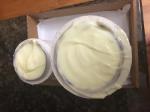Does Anyone Know A Very Slow Tracing Recipe
by Christine
(UK)
Does anyone know of a fool-proof 'slow tracing' recipe? I would love to try doing some swirls but by the time I mix the colours to the trace, my recipes always seem to thicken up too quickly.
Sometimes the mixture thickens within one minute after adding the lye and stick blending for only a 5 second burst(esp. on recipe 2)! I can't blame the fragrance there. Here are 2 recipes I used:
Recipe 1
100g coconut oil
100g unrefined palm oil
100g olive pomace
10g avocado oil
10g almond oil
20g soybean
10g castor
10g unrefined shea
Recipe 2
50% coconut
20% castor
20% olive pomace
5% almond
5% avocado
On both recipes, I warmed the butters with the oils at the same time. Would this affect it?
Would prefer a vegan recipe please.
Answer:
I can see right away what the problem is! Here is a list of some of the oils that tend to trace quite quickly in soap making:
Babassu Oil
Coconut Oil
Castor Oil
Cocoa Butter
Lanolin
Lard
Palm Oil
Palm Kernel Oil
Pomace Oil
Shea Butter
Tallow
In recipe #1, 89% of the oils are quick tracing oils.
In recipe #2, 90% percent of the oils are quick tracing.
My suggestion would be to substitute the pomace oil with Grade A or B olive oil and if that isn't enough for recipe #2, you may want to bring down the percentages of coconut oil and castor oil and increase the olive oil.
Good luck,
Cathy
Comments for Does Anyone Know A Very Slow Tracing Recipe
|
||
|
||
|
||
|
||

